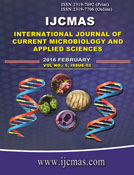


 National Academy of Agricultural Sciences (NAAS)
National Academy of Agricultural Sciences (NAAS)

|
PRINT ISSN : 2319-7692
Online ISSN : 2319-7706 Issues : 12 per year Publisher : Excellent Publishers Email : editorijcmas@gmail.com / submit@ijcmas.com Editor-in-chief: Dr.M.Prakash Index Copernicus ICV 2018: 95.39 NAAS RATING 2020: 5.38 |
The flower of Syzygium aromaticum (clove), a common food flavor, has been used as indigenous medicine for the treatment of several diseases in Asian countries. Safety assessment of S. aromaticum flower bud (clove) extract with respect to antimicrobial activity against two bacterial isolates. Moreover, the main work was characterizing the chemical components if alcoholic extract of S. aromaticum flower bud (clove) in terms of detection of Nitrogen, Sulfur, Halogens, Phenol, aldehydes, ketones and anthraquinones detection. Also Fourier Transform Infrared Spectroscopy (FTIR) and Ultraviolet (UV) spectrum analysis were used for attributing the extract. The result showed that the main composition of the extract was ketones and anthraquinones, the last one was responsible for biological activity of the extract. Furthermore, FTIR results showed morethan eight peaks for represent the main fine composition of the extract. UV spectrum showed that thae main absorption at 224, 268 and 348 nm due to the electronic transition from the type *n-π for group of alcohol that bind with aromatic ring, * n-π of group carbonyl bind with aromatic ring of quinone and * π-π of the group of ketone that bind with aromatic ring. The present study also showed that the extract has antibacterial activity against two bacterial isolates Bacillus and Serratia marcescens.
 |
 |
 |
 |
 |